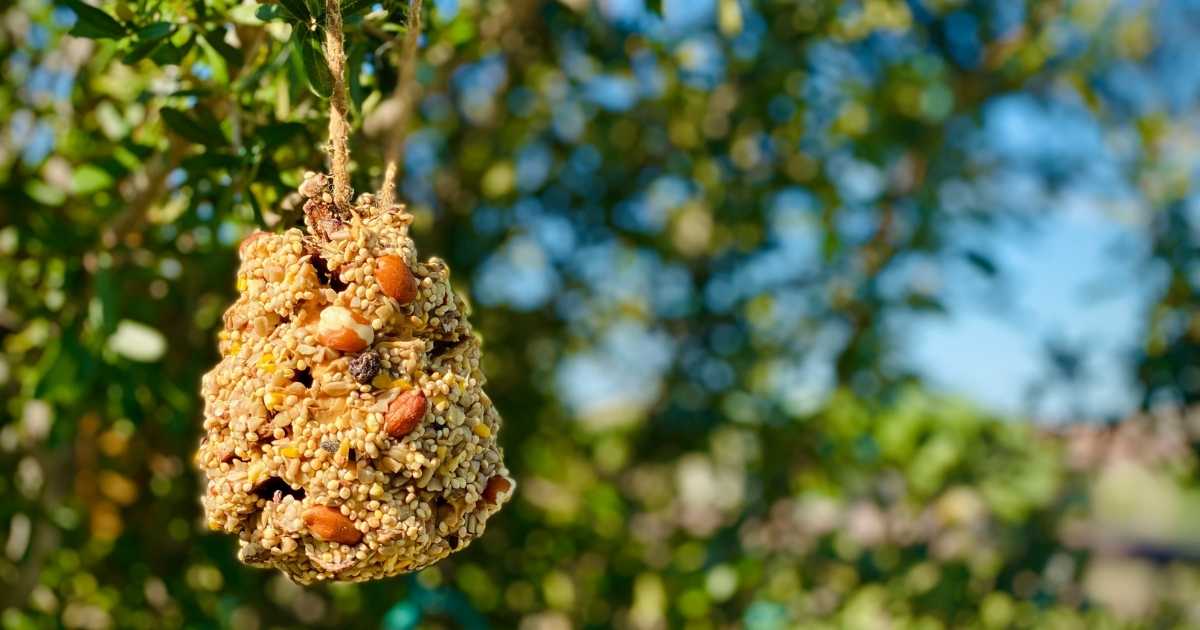Repotting a Fiddle Leaf Fig Tree: In Less Than 10 Easy Steps
In this comprehensive guide, repotting a Fiddle Leaf Fig Tree: In Less Than 10 Easy Steps, we’re diving deep into every aspect of the repotting process, from spotting the signs that it’s time to transplant to selecting the optimal soil mix and the ideal pot size.
Whether you are a seasoned gardener or this is your first fiddle leaf fig experience, these easy step-by-step instructions on how to transplant a fiddle leaf fig tree, plus essential aftercare tips to keep your plant thriving, are here to help. 🙂
Let’s get started.
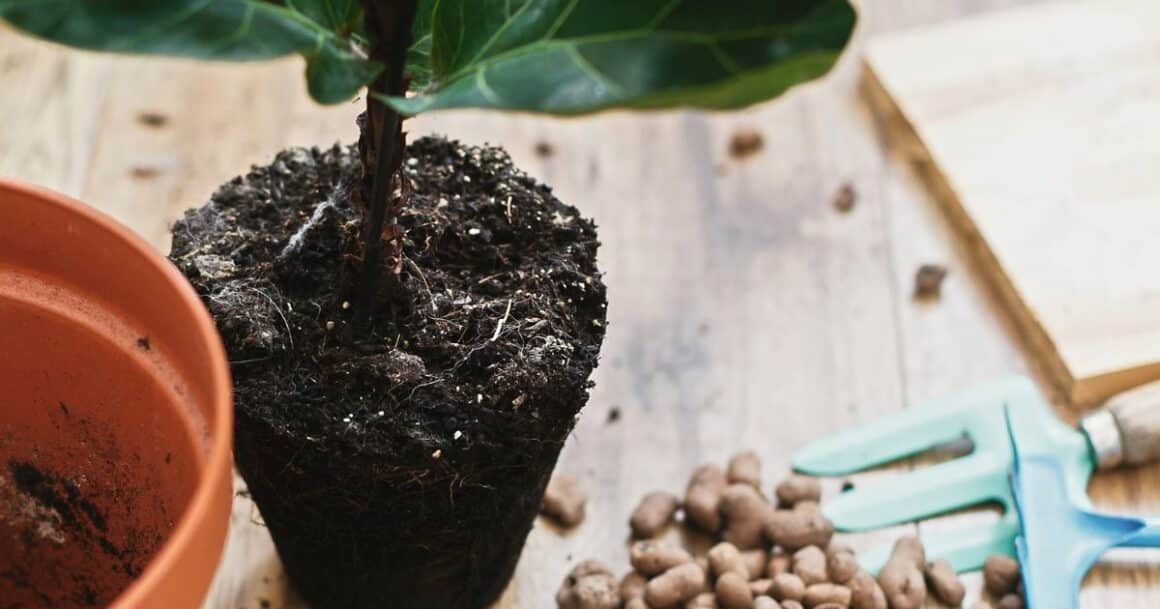
The Need for Repotting a Fiddle Leaf Fig Tree
You might need to repot that gorgeous green buddy of yours for several reasons.
Root bound: If your plant’s roots are peeking out of the drainage holes or roots circling the top of the soil, it’s outgrown its existing pot.
Soil Exhaustion: Over time, the soil loses its nutrients. If your plant’s been in the same pot for a couple of years, it might be craving fresh, new soil.
Stunted Growth: If your plant isn’t growing like it used to, it might be because the root ball is feeling too cramped.
Root Rot: If caught in the early stages, repotting can help you remove the rotten roots and save a sick or dying plant, giving it a fresh start.
Change in Soil pH: Sometimes, the soil can become too acidic or alkaline for your plant. A repot with fresh soil can help reset the balance.
Pests & Bugs: If you’ve got unwanted critters in the soil, sometimes the easiest way to evict them is to repot.
Fresh Look: Let’s be honest, sometimes we just want to switch things up and give our plant a stylish new home!
Compacted soil: Over time, soil can become super compacted, making it hard for roots to breathe and grow.
Better Drainage: Maybe the current container doesn’t have the best drainage, and you want to upgrade to prevent overwatering.
Yellow leaves, brown spots, or dropping leaves. If your fiddle plant has yellow leaves, brown spots, or dropping leaves, you may want to consider repotting it.
In this case, you can use the same pot, treat the roots, and replace the soil.
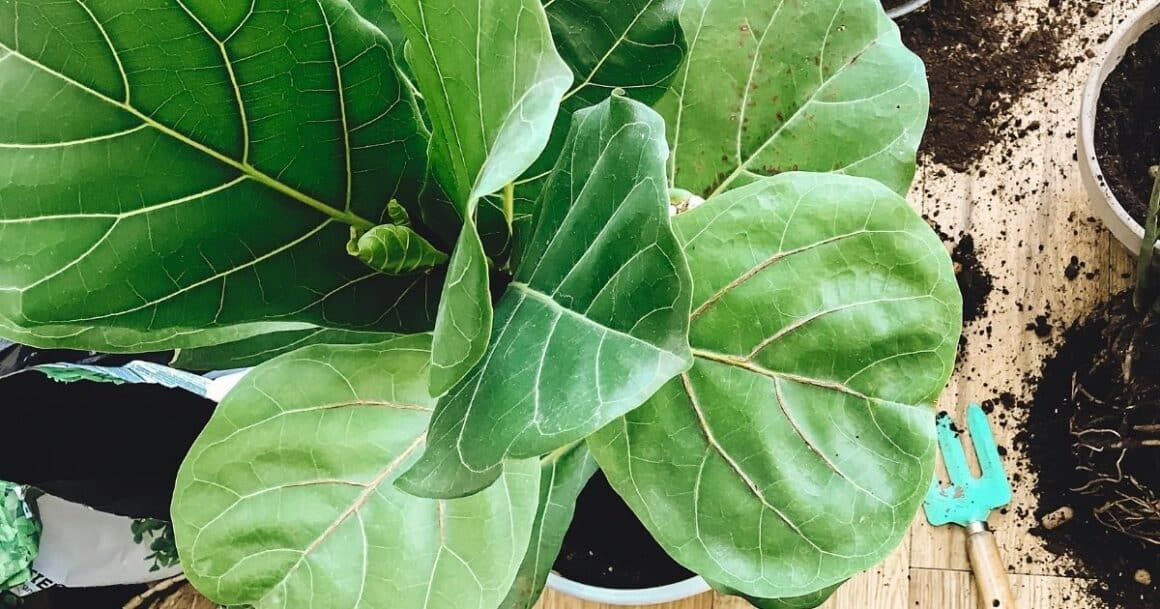
The best time to repot a fiddle leaf fig
When it comes to repotting your fiddle leaf fig, timing is key. So, when’s the best moment to give your plant a new home?
Springtime is the golden ticket! If you can wait till spring, that is.
If you notice urgent issues like severe root rot or extreme root-bound conditions, don’t wait.
Address the problem ASAP, even if it’s not spring. Just ensure you give your plant some extra TLC to help it adjust.
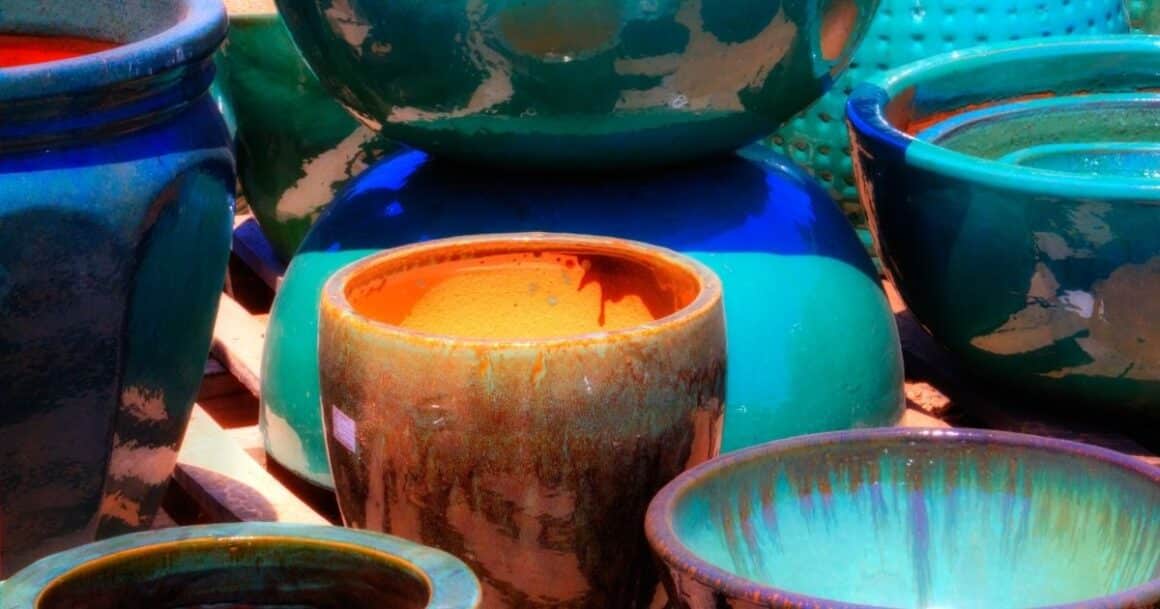
Things to Consider when Choosing the Best Pot for a Fiddle Leaf Fig Plant
Different Types of Pots for your Fiddle Leaf Fig Plant:
Ceramic Pot
Ceramic pots are made from clay and baked in kilns at high temperatures. They often come glazed, giving them a shiny finish and a vast array of colors and designs.
Pros of using a ceramic pot:
- Aesthetic Appeal: Their diverse designs and finishes can complement almost any interior style.
- Weight: They’re heavier, which can be great for top-heavy plants or placements where you don’t want the pot easily knocked over.
- Moisture Retention: The glaze can help retain moisture, which is beneficial for plants that don’t like drying out too quickly.
Cons to using a ceramic pot:
- Weight (again!): Their heaviness can be a downside if you need to move your plants frequently.
- Price: They can be pricier than some other options.
- Drainage: Ensure they have drainage holes; otherwise, you risk overwatering.
Decorative Container
These are often used as an outer layer for your plant’s primary pot. They can range from woven baskets to metal containers, wood boxes, and more.
Pros of using a decorative container:
- Versatility: Easily switch up your plant’s look without the hassle of repotting.
- Protection: They can catch any excess water, protecting surfaces from potential damage.
- Style Statement: They can elevate the aesthetic appeal of even the most basic pots.
Cons of using a decorative container:
- Drainage: Most decorative containers don’t have drainage holes, so always ensure the inner pot does to prevent waterlogging.
- Size Matching: Ensure the decorative container fits your plant’s primary pot.
Plastic Pot
Plastic pots are lightweight pots made from various types of plastic. They’re often the type of pot plants come in when purchased.
Pros and cons of using a plastic pot:
Pros:
- Lightweight: Easy to move around, especially beneficial for larger plants.
- Affordable: Generally cheaper than ceramic or decorative options.
- Variety: They come in various colors and designs, though they might not always have the same aesthetic appeal as ceramic pots.
- Moisture Retention: Plastic doesn’t breathe like terracotta, so it retains moisture longer.
- Cons :
- Durability: They can become brittle over time, especially when exposed to sunlight.
- Aesthetics: Some might find them less attractive than other options.
- Environmental Concerns: They’re not as eco-friendly as some other materials.
Ultimately, the best pot or container for your plant depends on your plant’s needs and your personal style preferences.
In addition, there are some nifty accessories that can not only make the process smoother but also elevate the aesthetics of your plant setup.
Plant Saucers: A plant saucer is like the unsung hero of plant accessories. Why’s it so great?
- Moisture Management: It catches any excess water that drains out, preventing messy spills and protecting your floors or furniture.
- Root Health: Preventing water from sitting at the bottom of your pot helps avoid root rot.
- Easy Movement: Need to shift your plant around? The saucer makes it a breeze, especially if it’s on wheels!
Plant Stand: Elevate your fiddle leaf fig (literally!) with a stylish plant stand.
- Aesthetic Appeal: A plant stand can transform your fiddle leaf fig into a statement piece in any room.
- Improved Airflow: Elevating your plant can ensure better airflow around it, which can benefit overall health.
- Protection: Keeping your plant off the ground can protect it from cold drafts, pests, or playful pets!
Decorative Container: As you mentioned, if your pot’s looking a bit plain, jazz it up with a decorative container!
- Style Statement: From woven baskets to chic metal containers, there’s something for every decor style.
- Double Protection: An outer decorative container can provide extra protection against water damage or soil spillage.
- Versatility: Tired of the current look? Swap out the decorative container for a fresh vibe without the hassle of repotting.
Adequate Drainage
Drainage is another important consideration when selecting a pot for your fiddle leaf fig.
Proper drainage helps prevent root rot, which can occur when the plant’s roots sit in water for extended periods.
Be sure to select a pot with at least one large drainage hole or several small drainage holes at the bottom to facilitate proper drainage.
In the case of a decorative pot without drainage holes, you can place the plant in an interior container and position this container within the decorative pot.
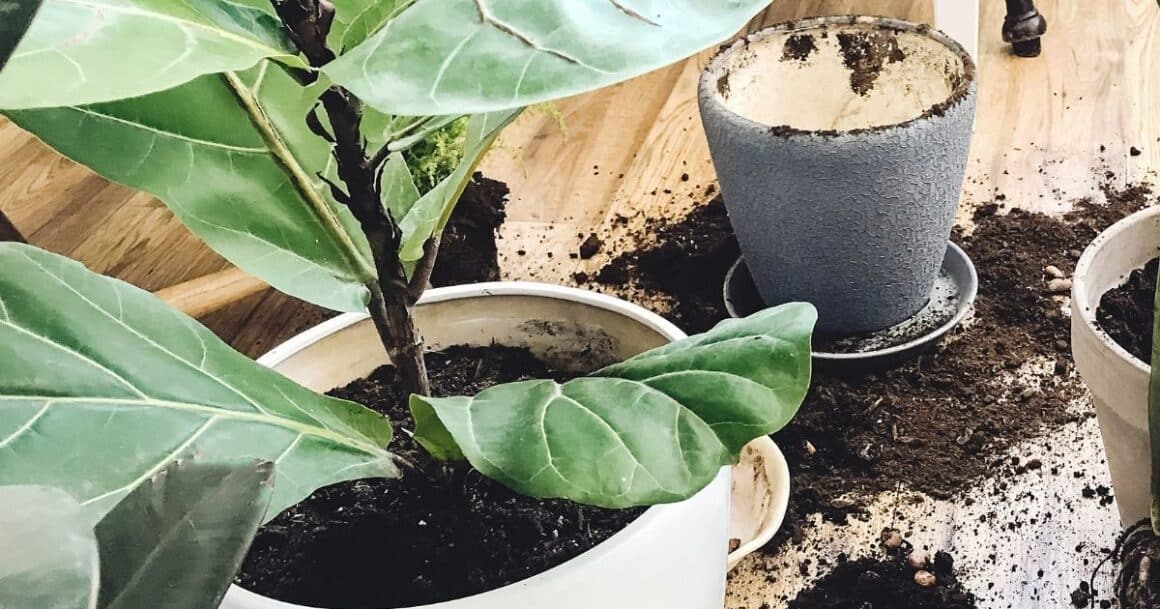
Determining the correct sized pot size for repotting a fiddle leaf fig tree
Choosing the right pot size for repotting your fiddle leaf fig is crucial for its health and growth.
Here’s a guide to help you make the best choice:
Check the Current Size
Start by assessing the size of the pot your fiddle leaf fig is in.
Go Up Gradually
As a general rule, you’ll want to choose a pot 2-3 inches (5-7.5 cm) larger in diameter than the current one.
This gives the roots enough room to grow but doesn’t overwhelm the plant with too much space.
Avoid Oversizing
While putting your fiddle leaf fig in a much larger pot might be tempting to reduce the frequency of future repottings, this can be counterproductive.
A pot that’s too large can retain too much moisture, increasing the risk of root rot.
Depth Matters
Ensure the pot is not just wider but also deeper than the current one. Fiddle plants have robust root systems that need depth to grow.
Material Consideration
The material of the pot can also influence the size choice. For instance, terracotta pots are porous and can dry out faster, so if you’re choosing terracotta, you might opt for the larger end of the 2-3 inch increase.
On the other hand, plastic or ceramic pots retain moisture longer, so you might lean towards the smaller end of the range.
Assess the Roots
When you remove your fiddle leaf fig from its current pot, take a moment to inspect the roots.
If they’re densely coiled around the root ball (root-bound), you might consider going up by 3 inches. If they seem to have a bit of space, a 2-inch increase might suffice.
Future Growth: If you know your fiddle leaf fig is a particularly fast grower or if it’s in a growth spurt phase, leaning towards a slightly larger pot might be beneficial.
While the 2-3 inch increase is a good general guideline, always consider your fiddle leaf fig’s specific needs and conditions. Ensuring it has the right amount of space will set it on the path to thriving in its new home!
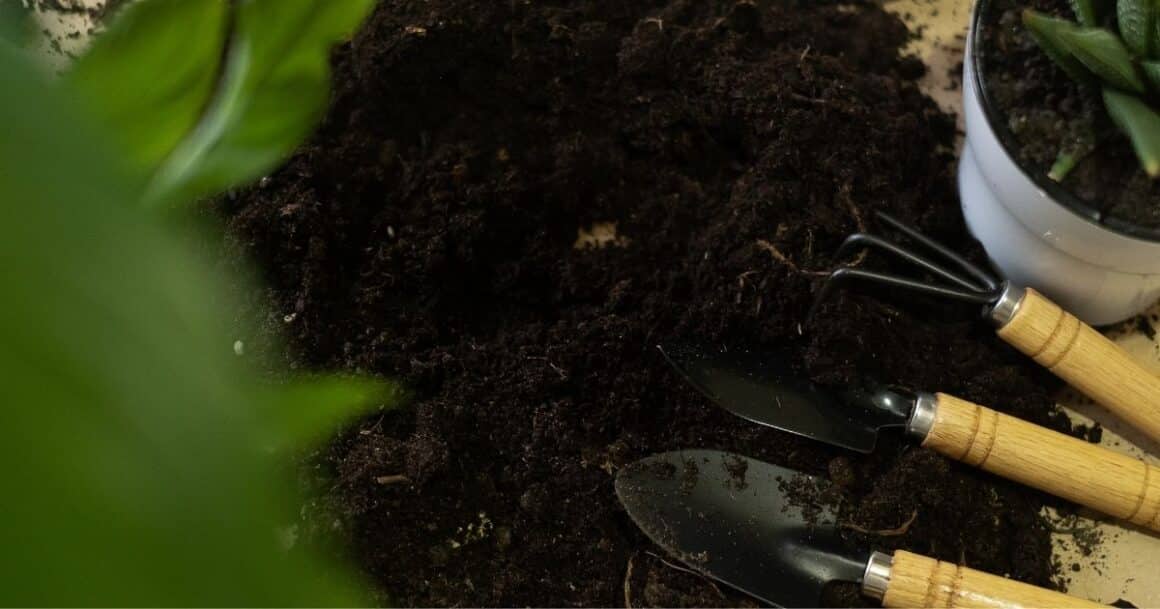
The Best Soil Mix for Fiddle Leaf Figs
Like most plants, fiddle-leaf fig trees thrive when they’re in the right soil.
These plants hail from the tropical rainforests of West Africa, so they’re used to well-draining soil that can hold onto moisture without getting soggy.
Key Components for the Perfect Fiddle Leaf Fig Soil Mix:
Well-Draining Soil
This is the golden rule! Fiddle leaf figs despise “wet feet.” Their roots need oxygen, and if they’re sitting in waterlogged soil, they can easily develop root rot.
Aerating Ingredients
Things like perlite or sand can be mixed in to promote airflow to the roots and ensure the soil doesn’t compact over time.
Organic Matter
Ingredients like peat moss or coconut coir can help the soil retain the right amount of moisture. They also make the soil a bit acidic, which fiddle leaf figs tend to like.
Bark
A bit of pine bark can mimic the natural environment of the fiddle leaf fig, improving drainage and adding some organic nutrients.
Ready-made potting soil vs. DIY potting Mix:
- Ready-Made potting soil: There are commercial soil mixes designed explicitly for fiddles. These are great if you want a no-fuss solution. Just ensure it’s labeled as fast-draining or suitable tropical.
- DIY potting soil: If you’re feeling adventurous or particular about your mix, you can create your own soil mix! A popular blend is:
- 3 parts of a general-purpose potting mix
- 2 parts perlite or coarse sand for aeration
- 1 part pine bark for that touch of acidity and improved drainage
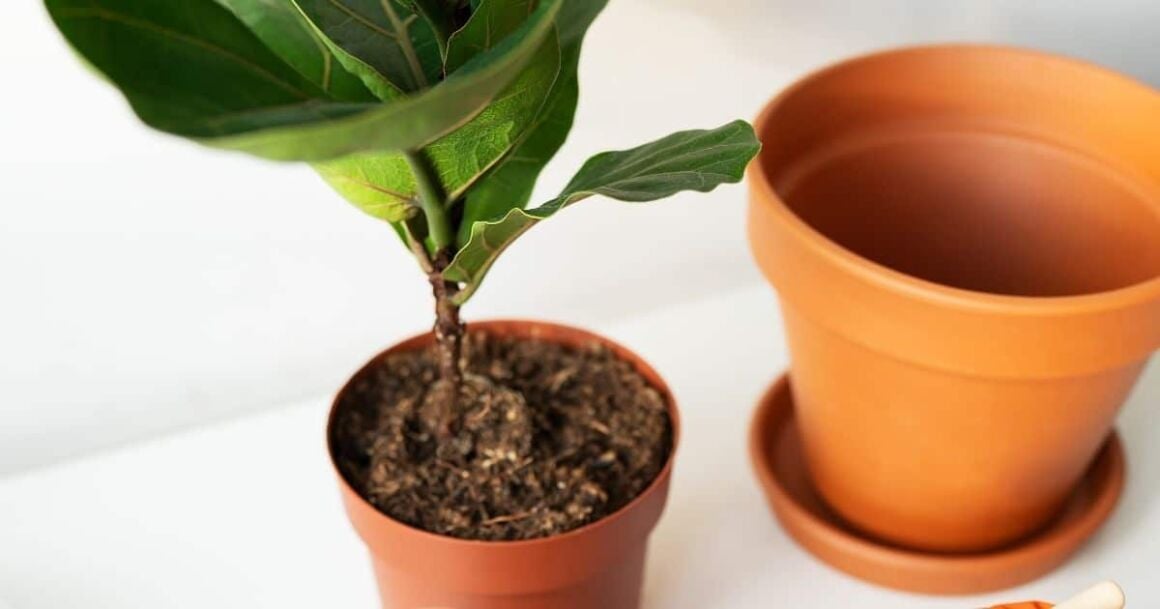
Step-by-Step Guide to Repotting a Fiddle Leaf Fig Tree
Now that you’ve identified when repotting is needed and chosen the appropriate pot and soil, you’re ready to transplant your fiddle!
In this step-by-step guide, we will walk you through removing the plant from its current home, preparing the new pot and soil, and placing it in the new pot with fresh soil.
These steps will aid the smooth transition of your fiddle leaf fig into its new home, contributing to its ongoing health and growth.
1. Gather Supplies and Prep Work Space
Lay down newspapers or a tarp in a spacious area. This will catch any stray soil and make cleanup easier.
Supplies Needed to Repot a Fiddle Leaf Plant:
- New pot (with drainage holes)
- Fresh potting soil
- Pea gravel or LECA pebbles
- Trowel
- Watering can
- Scissors or pruning shears
- Gloves (optional, but handy)
- Soil toppers (like moss or decorative stones)
- Lay down newspapers or a tarp in a spacious area. This will catch any stray soil and make cleanup easier.
2. Remove the plant from Its current home
- Gently tilt the plant to the side, supporting the main stem with one hand.
- With your other hand, tap the bottom and sides of the pot to loosen the soil and roots.
- Gently pull the plant out. If it’s being stubborn, you can use a knife or spatula around the inside edge of the pot to help ease it out.
- Remove old compacted soil from the root ball. Take this time to examine all the roots, removing any root rot or disease areas of the root ball.
- Spray root ball with hydrogen peroxide to help with root rot or fungal infections.
3. Add a bottom layer of pea gravel or LECA pebbles
Pour a layer of pea gravel or LECA pebbles at the bottom of the new pot. This ensures excellent drainage and prevents the roots from sitting in stagnant water.
Related article: How to use LECA Clay Pebbles
4. Add Potting Mix And Position the Fiddle Leaf Fig
Add some fresh potting mix to the new pot on top of the drainage layer. This creates a base for your plant to sit on.
Place the plant in the center of the new pot. The top of the root ball should sit about an inch below the pot’s rim, allowing space for watering.
5. Add More Soil & Eliminate Air Pockets
- Fill in the gaps around the plant with more potting soil.
- As you add soil, gently tap the pot on the ground to help the soil settle and eliminate air pockets. Air pockets can dry out the roots and cause problems.
- Another trick is to use a stick or the handle of your trowel to gently poke the soil, helping it settle around the roots.
6. Apply Soil Toppers
Once your plant is snug in its new home, consider adding a soil topper. Moss or decorative stones look great and can deter pests and help retain water retention.
These toppers act as a barrier, making it harder for pests like fungus gnats to lay eggs in the soil.
7. Water Your Plant
Give your fiddle leaf fig a good drink, but don’t drown it. Watering will also help the soil settle further and eliminate any remaining air pockets.
8. Place the Fiddle in its Usual Spot
Place your newly potted fiddle leaf fig in a spot with indirect-bright light. Monitor its water needs closely for the next few weeks as it adjusts to its new environment.
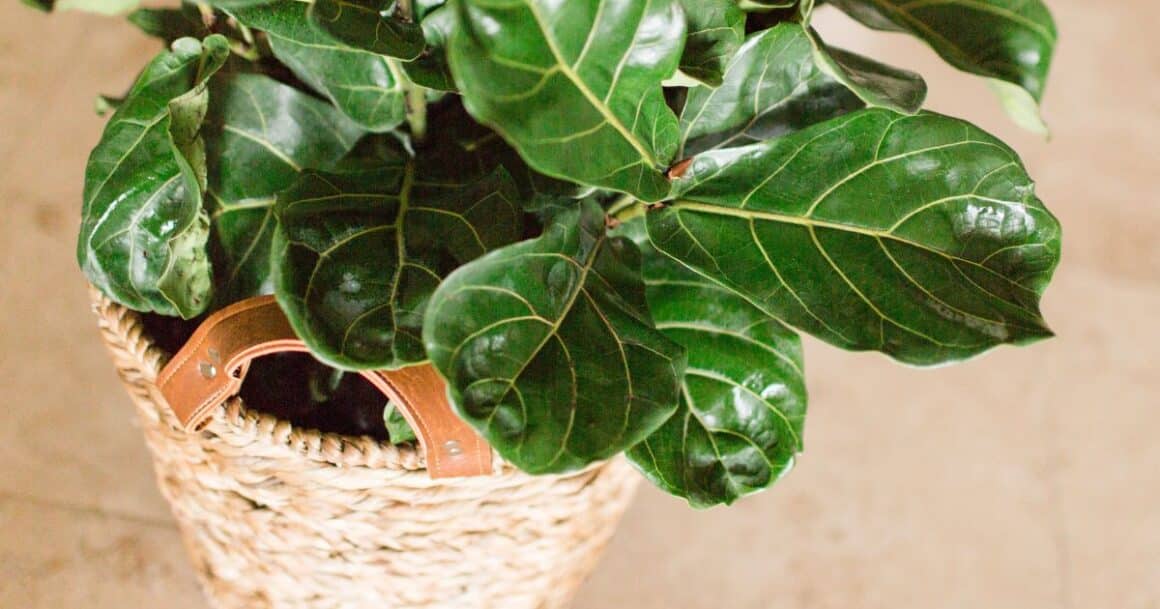
Caring for a Newly Transplanted Fiddle Leaf Fig
A mix of appropriate watering, fertilizing, and ensuring sufficient light and humidity is key to successfully growing and maintaining fiddle leaf figs.
Water routine
To ensure your plant receives the right amount of water, follow these steps:
Water when the top inch or two of soil is dry. Be mindful of overwatering and underwatering, as both can lead to issues with your plant’s health.
Use filtered or distilled water for best results.
Fertilizing your fiddle leaf fig
is also essential for its overall health and promotes growth.
Utilize a balanced fertilizer with equal parts nitrogen, phosphorus, and potassium to give the plant the necessary nutrients.
Be sure to wait at least a month after repotting before fertilizing to give the plant time to adjust to its new environment.
Create the right environment for your fiddle leaf fig
Here are some tips to ensure your plant thrives:
- Ensure that your plant receives bright, indirect sunlight
- Maintain a humidity level between 40-60%
- Understand your fiddle’s specific needs and adjust your care routine accordingly.
FAQs: How to Transplant a Fiddle Leaf Plant
Can I use cactus mix to transplant a fiddle leaf fig tree?
While cactus soil is designed for plants that require excellent drainage, it might be too well-draining for a fiddle leaf fig.
However, if you’re in a pinch, you can use it but consider mixing it with regular potting soil (about a 50:50 ratio) to ensure the fiddle leaf fig retains enough moisture.
How much light does my fiddle leaf fig need a day?
Fiddle leaf figs thrive in bright, indirect light. A spot near an east-facing window where it can get morning sunlight is ideal.
If placed near a south or west-facing window, ensure it’s protected from direct afternoon sun, which can scorch its leaves. Aim for at least 6-8 hours of bright, indirect light daily.
Are fiddle leaf fig plants easy to grow? What if I don’t have a green thumb?
I know that my Fiddle fig can be a bit finicky compared to some other houseplants.
They’re sensitive to environmental changes like being moved or watered inconsistently. However, they can thrive with the right care – proper lighting, watering, and occasional feeding.
If you’re new to plant care, it might have a bit of a learning curve, but don’t be discouraged! Every plant parent learns along the way.
What does it mean if my fiddle plant has brown spots?
- Overwatering: This can lead to root rot, which like the kiss of death.
- Underwatering: If the plant isn’t getting enough water, the leaves can dry out and develop brown areas.Sunburn: Direct sunlight can scorch the leaves, leading to brown patches.Pests or Disease: Insects like spider mites or fungal infections can also cause browning.Cold Damage: Exposure to cold drafts can cause brown spots or edges.
Can I use garden soil to transplant my fiddle leaf fig tree?
It’s essential to use the right potting soil for indoor plants. and garden soil is too dense, leading to poor drainage. It might also contain pests, diseases, or weed seeds. Instead, opt for a high-quality indoor soil mix.
Where is the best place to buy new soil for my fiddle leaf tree?
The best place to purchase new soil is from the local nursery or garden center.
Big-box home improvement stores also typically have a garden section with various soils suitable for indoor plants.
If you prefer shopping online, websites like Amazon, Walmart, Target or specialized plant shops offer a variety of soils, often with user reviews to help guide your choice.
What are other names for a fiddle leaf fig tree?
The scientific Name for a fiddle plant is Ficus lyrata. There are also several common names and nicknames:
- Fiddle Leaf Fig
- Fiddle Leaf Fig Tree
- Fiddle plant
- Fiddle Fig
- Banjo Fig (less common)
- Flute Fig (less common)
While “Fiddle Leaf Fig” is the most widely recognized common name due to the shape of its leaves resembling a fiddle (or violin), the plant is a member of the Ficus genus, which includes other popular plants like the rubber plant (Ficus elastica) and the weeping fig (Ficus benjamina).
Conclusion: How to Repot a Fiddle Leaf Fig Tree
In this detailed guide, we’ve delved deep into the nuances of the repotting process.
From identifying when your fiddle leaf fig is yearning for a new home to selecting the perfect pot and soil blend and mastering the repotting steps, you’re now fully prepared to give your plant the refresh it deserves.
With a touch of patience, diligent care, and a keen eye, your fiddle leaf fig will flourish in its new setting, gracing you with its magnificent leaves and robust growth.
And there you have it! Repotting fiddle leaf figs is simpler than you might’ve imagined.
Until next time, happy growing!

I’ve been keeping it real since 1963. 😊
I’m a child of God, devoted wife, proud mama and grandma, full-time creative, domestic engineer, and passionate self-care enthusiast.
I’m purpose-driven and do my best to live each day with intention—whether shopping for treasures, painting in my art studio, digging in the garden, or cooking up something yummy for my family.
I’m always up for a good chat and love collaborating with fellow creatives and brands.
Let’s connect—don’t be shy!





